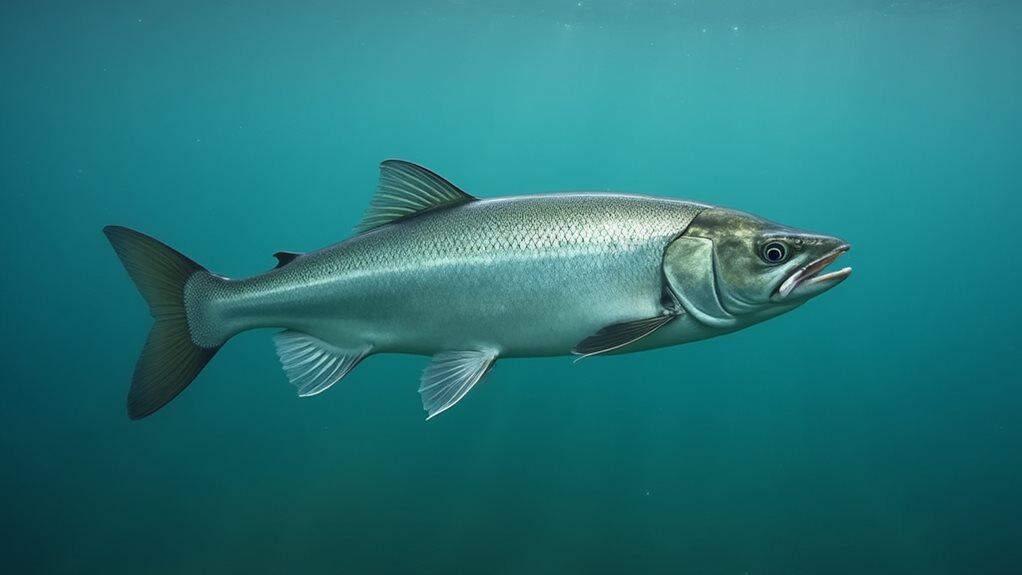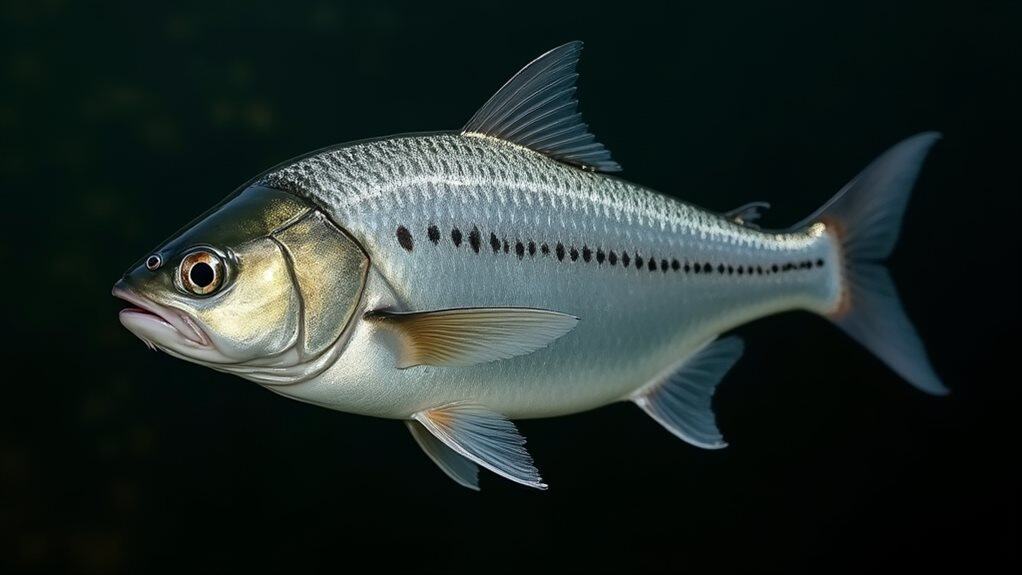You’ll easily identify a shad by its compressed, silvery body with a brilliant metallic sheen that creates a mirror-like appearance underwater. Look for the distinctive dark spot just behind the gill cover, along with smaller circular spots running along the upper body. They feature deeply forked tails, dark blue or green backs that fade to bright silver sides, and typically measure 16-22 inches long. Understanding these key characteristics will help you distinguish shad from similar species and improve your identification skills.
TLDR
- Shad have compressed, deep-bodied frames with silvery-green backs fading to bright silver sides and a distinctive ventral keel.
- Look for a prominent dark spot just behind the gill plate and smaller circular spots along the upper body.
- They display a brilliant metallic sheen with reflective scales that create rainbow effects under direct sunlight.
- Adult shad typically measure 16-22 inches long, with females being noticeably larger than males at 20-24 inches.
- The deeply forked tail with two pointed lobes is a key identifying feature that distinguishes shad from similar species.
Body Shape and Overall Structure

Identifying shad starts with recognizing their distinctive body structure, which reflects millions of years of evolutionary adaptation to their aquatic lifestyle.
You’ll notice their compressed, moderately deep-bodied frame with silvery, flat sides that create a streamlined appearance. The back arches more prominently than the belly, forming a distinct keel along the ventral midline, while the head remains relatively small. These fish display silvery-green coloration above that gradually fades to bright silver below. In addition, their unique morphology allows them to thrive in warm waters, similar to environments where species like black marlin are found.
Color Patterns and Metallic Sheen
The most striking feature you’ll notice when observing shad is their brilliant metallic sheen, which creates an almost mirror-like appearance as they move through the water. Their silvery sides contrast sharply with dark blue, green, or black backs. Under direct light, their reflective scales produce rainbow effects, shifting between silver, blue, and green depending on your viewing angle. This distinctive coloration explains why shad imitator lures like the popular Sexy Shad pattern have become so effective for anglers trying to match the natural appearance of these baitfish. Additionally, understanding frequency options is essential for choosing the right lures that mimic shad effectively.
Distinctive Dark Spots and Markings

Beyond their brilliant metallic coloration, American shad display a distinctive pattern of dark spots that serves as one of their most reliable identifying features.
You’ll notice one prominent dark spot located just beyond the gill plate, followed by a row of smaller, circular spots along the upper body.
This pattern distinguishes them from similar species like menhaden. Additionally, knowing fishing rod action can help anglers better understand how to effectively catch shad.
Size and Weight Variations
Most adults measure 16–22 inches long and weigh 2–5.5 pounds. You’ll notice females are considerably larger than males, averaging over 4 pounds and 20–24 inches, while males typically weigh 1–3 pounds. Exceptional females can reach nearly 30 inches and 12 pounds. Surf kayaking can be an exciting way to enjoy the water while observing various fish species, including shad, in their natural habitat.
Head and Jaw Characteristics

When examining an American shad’s head, you’ll immediately notice its relatively small size compared to the fish’s characteristically deep body.
The snout appears short and blunt, creating a rounded front profile that’s scaleless and smooth to touch.
You’ll find the mouth positioned below the snout tip, featuring a distinctive subterminal placement perfect for filter feeding.
Tail and Fin Features
You’ll find that examining a shad’s tail and fin configuration provides some of the most reliable identification markers for distinguishing between species.
The deeply forked tail design, combined with the specific positioning and shape of each fin, creates a distinctive swimming profile that’s immediately recognizable once you know what to look for.
These features aren’t just aesthetic differences—they’re functional adaptations that reveal how shad have evolved for their unique lifestyle of rapid migrations and schooling behavior.
Deeply Forked Tail Design
The deeply forked tail fin stands as one of shad’s most distinctive identifying features, setting these fish apart from many other freshwater species you’ll encounter.
This sharp, pronounced fork creates two pointed lobes that extend symmetrically from the caudal peduncle.
You’ll notice the silvery coloration matches their body, occasionally displaying darker edges that enhance the fork’s definition.
Fin Shape and Function
Beyond their signature forked tail, shad possess a complete set of fins that work together as an integrated propulsion and control system, each serving specific functions essential for their survival in freshwater environments.
You’ll notice their pectoral fins provide steering and balance, while dorsal and anal fins offer stability during swimming maneuvers and quick directional changes.
Swimming Adaptation Features
These carefully designed fins work in concert with shad’s most distinctive swimming feature—their deeply forked tail, which represents a skillful evolutionary adaptation for life in flowing water.
You’ll notice this forked design reduces drag while increasing propulsion efficiency, allowing shad to achieve maximum speeds of 4.3-5.4 m/s and maneuver river currents with extraordinary precision during their upstream migrations.
Belly Scales and Texture
Close examination of gizzard shad belly scales reveals a sophisticated system designed for both protection and hydrodynamic efficiency.
You’ll notice these cycloid scales are smaller, thinner, and smoother than lateral scales, lacking prominent spines. Their pale, whitish coloration contrasts with darker dorsal scales, while the slimy mucus coating reduces friction and provides streamlined swimming performance.
Seasonal Color Changes

As seasons progress throughout the year, you’ll observe dramatic shifts in shad coloration that reflect their extraordinary ability to adapt to changing environmental conditions.
During spring spawning runs, they display bright, vivid silver hues in clearer waters.
Fall brings duller, darker tones for murky conditions, while winter produces pale, muted colors with reduced contrast.
Final Note
You’ll find shad identification becomes straightforward once you recognize their key features. Look for their deep, compressed bodies with silvery sides and that distinctive metallic sheen. Don’t forget to check for the dark shoulder spot and examine their deeply forked tails. Remember that seasonal variations can affect their coloration, so you’ll want to take into account the time of year when making your identification. Practice observing these characteristics, and you’ll confidently identify shad in any fishing situation.




